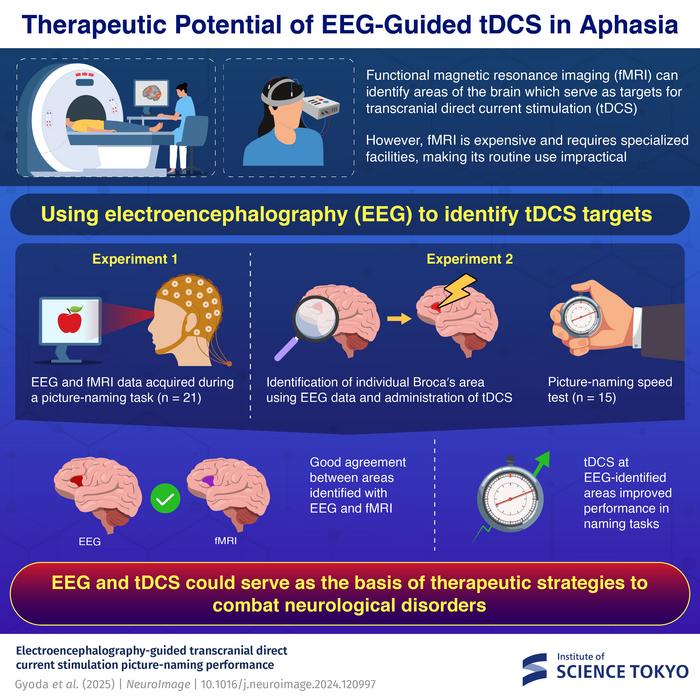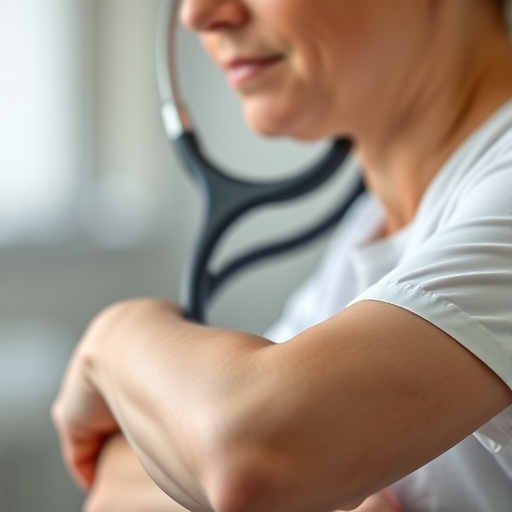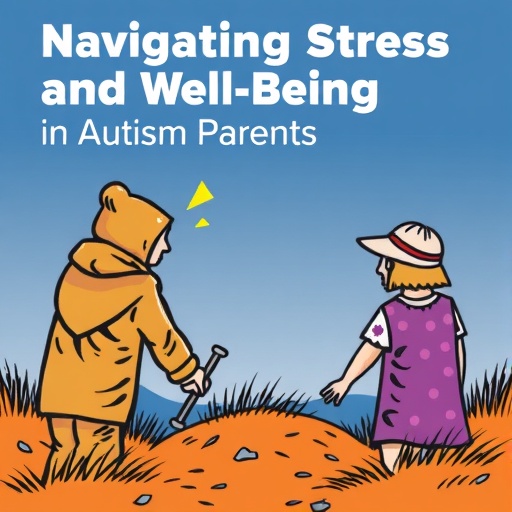Electroencephalography (EEG) has gained recognition as a promising alternative to functional magnetic resonance imaging (fMRI) in the realm of neurological research and therapeutic applications, particularly for conditions such as aphasia. A recent study conducted by researchers at the Institute of Science Tokyo presents groundbreaking findings that demonstrate the feasibility of using EEG to guide transcranial direct current stimulation (tDCS) in patients with language impairments. The study highlights an exceptional 80% concordance between EEG and fMRI in identifying brain regions activated during language tasks, propelling EEG forward as a more accessible and practical method for clinical settings.
Aphasia, a disorder deeply intertwined with the neural architecture of speech production, is primarily associated with dysfunction in Broca’s area—a critical region located in the frontal lobe of the brain. Treatments for aphasia have historically been limited, with tDCS emerging as one of the more innovative approaches to modulate brain activity. By applying low electrical currents to the scalp, tDCS may enhance or inhibit neuronal activity, effectively aiming to restore or improve speech production capabilities. The traditional reliance on fMRI in this context has posed several challenges, including the need for extensive infrastructure and specialized personnel. Hence, the potential integration of EEG as a guiding technology for tDCS applications stands to revolutionize therapeutic strategies for aphasia treatment.
In a literature review, it becomes evident that the relationship between brain regions and behavioral outcomes is complex, necessitating the development of more refined approaches to cognitive rehabilitation. The emergence of EEG as a tool for this purpose is noteworthy, as it is not only cost-effective but also portable, allowing for its use in diverse clinical environments. With the recent findings from the study led by Professor Natsue Yoshimura, the scientific community is intrigued by the implications that EEG-guided tDCS may have for personalized treatment protocols that adapt to the unique neural patterns of individuals with aphasia.
The research team undertook a rigorous experimental setup to validate the hypothesis surrounding EEG’s utility. Two distinct experiments were performed, with the first involving the collection of EEG and fMRI data from 21 healthy participants engaged in picture-naming tasks. This phase of the research aimed to identify and compare the areas of brain activation detected using both methods. The high level of agreement between EEG and fMRI recordings underscores the reliability of EEG in pinpointing crucial neuronal activity associated with language tasks. These impressive concordance results bolster the argument for integrating EEG into the clinical toolkit for language-related disorders.
In the second experimental phase, the focus shifted to evaluating the effects of applying tDCS to brain areas as determined by EEG readings. Unlike conventional approaches where Broca’s area is targeted based solely on an averaged geometrical position, the EEG-guided methodology enables a tailored stimulation approach. The researchers observed notable improvements in the speed of picture-naming tasks among participants receiving the EEG-informed stimulation, reinforcing the hypothesis that EEG can enhance the effectiveness of tDCS in language therapies.
Crucially, these findings not only affirm the utility of EEG but also suggest a paradigm shift in how treatment for aphasia might be approached. By embracing variations in individual brain activity, EEG can facilitate personalized treatment strategies in ways that traditional applications cannot. This study sets an important precedent in advocating for a more individualized methodology to cognitive rehabilitation, paving the way for future explorations into its efficacy across broader patient populations.
Moreover, the implications of EEG’s role extend beyond just the realm of aphasia, suggesting that its application could be broadly beneficial to various cognitive disorders. As researchers continue to investigate the neural dynamics associated with cognitive function, EEG could provide valuable insights into how brain areas correlate with specific cognitive tasks. A deeper understanding of these relationships may allow for more accurate identification of dysfunctions and more targeted therapies tailored to individual needs.
Despite the promising outcomes of the current study, it is vital for the scientific and medical communities to remain cautious about overstating the effects of EEG-guided tDCS. Future studies will be essential in replicating these findings, assessing long-term efficacy, and determining optimal stimulation protocols. Additionally, further explorations into the limitations of EEG, particularly concerning its spatial resolution, are necessary to refine its application in clinical practice.
The research conducted at the Institute of Science Tokyo marks a significant advancement in the field of neurorehabilitation. The authors express a commitment to advancing therapeutic strategies and improving clinical outcomes for individuals affected by aphasia through continued research and innovation. Given the excitement surrounding these findings, there is a clear call for the development of more comprehensive treatment frameworks that incorporate emerging technologies like EEG into mainstream practices.
As we await the next wave of research, the integration of EEG into rehabilitative strategies raises essential questions about the future of cognitive therapy. Will we see a paradigm shift in how speech-language pathologists approach treatment for aphasia, utilizing portable and accessible technologies? The answers to these questions could define the landscape of cognitive therapy, potentially leading to transformative outcomes for patients struggling with language disorders.
In conclusion, this groundbreaking research serves as a beacon of hope for those affected by aphasia and similar neurological disorders. The combination of EEG and tDCS presents a novel pathway toward more effective, personalized treatments that align closely with the unique neural patterns of individuals. With ongoing studies set to build upon these findings, the future looks promising for those seeking to reclaim their language capabilities.
Subject of Research: EEG-guided tDCS for aphasia treatment
Article Title: Electroencephalography-guided transcranial direct current stimulation improves picture-naming performance
News Publication Date: 6-Jan-2025
Web References: http://dx.doi.org/10.1016/j.neuroimage.2024.120997
References: NeuroImage (2025)
Image Credits: Institute of Science Tokyo
Keywords: EEG, tDCS, aphasia, neurorehabilitation, cognitive therapy, Brain activity, Neuroscience, Functional mapping, Language disorders.
Tags: accessibility of neurological research toolsbrain activity monitoring techniquesclinical applications of EEG technologycomparing EEG and fMRI in neuroscienceEEG for aphasia treatmentElectroencephalography in language disordersimproving speech capabilities with tDCSinnovative therapies for language impairmentsneural architecture of speech disordersnon-invasive brain stimulation techniquesspeech production rehabilitation methodstranscranial direct current stimulation applications





